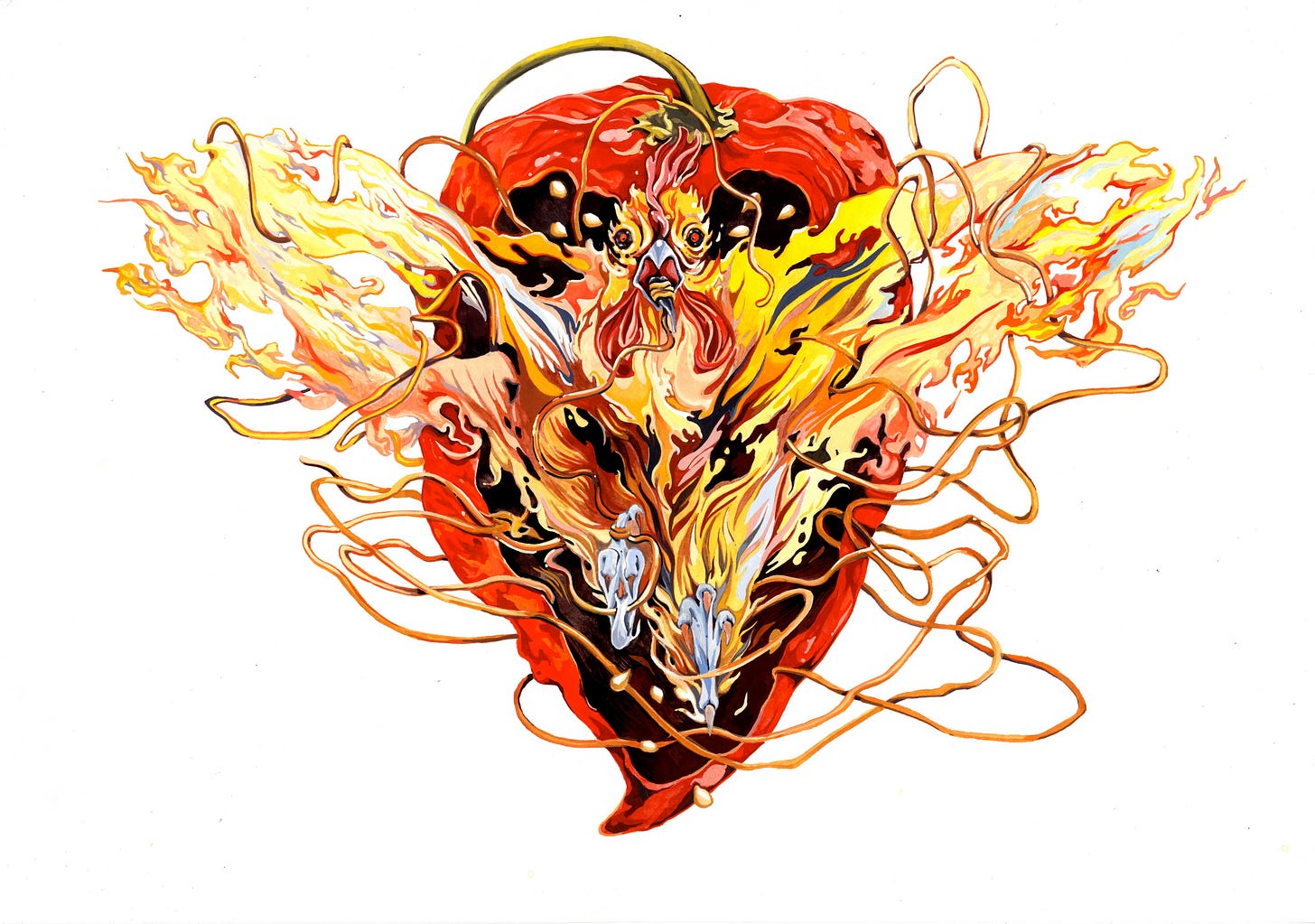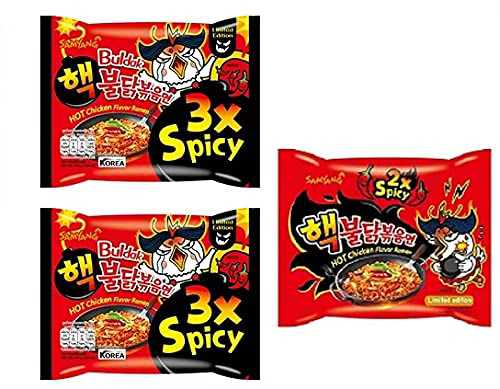White People Spicy
How the regulation of spicy food feeds racial anxieties. Words by Kerry McInerney. Illustration by Sing Yun Lee.
Good morning, and welcome to Vittles! Today, Kerry McInerney explores the relationships between the rise of super spicy foods, viral internet challenges and ‘Asian food’ as spectacle.
On Friday we published an updated guide of the best places to eat in Central London (focusing on Farringdon, Clerkenwell, Holborn, Bloomsbury, Covent Garden, the Strand and Fleet Street). You can read it, and the last five years of restaurant recommendations with a subscription to Vittles, which costs £7/month or £59 for the whole year.
White People Spicy
In June last year, the DVFA – Denmark’s food administration body – issued a recall of three types of instant ramen produced by the Korean company Samyang. The recall was not sparked by concerns about contamination; rather, the DVFA claimed that these ramen flavours were so spicy that their levels of capsaicin (the active ingredient in chilli peppers) posed a risk of ‘acute poisoning’ to consumers. They cited fourteen calls to the Danish poison hotline from people who had experienced abdominal pain and vomiting after eating the noodles.
The global popularity of Samyang’s Buldak ramen meant that the story quickly gained traction online. Denmark – renowned for its new Nordic cuisine, which has revolutionised fine dining over the past twenty-five years – was ridiculed as a bland, spice-averse country. As one Reddit user wrote, ‘this is the whitest shit I've ever heard of, and I’m in the Midwest’ (another responded, ‘Lol I agree. I’m embarrassed to be Danish’). Even Fortune, in its coverage of the ban, cheerfully announced the noodles were ‘too spicy for Europeans’. Just over a month later, a challenge from Samyang’s legal team prompted an independent study by the Danish National Food Institute, which found that of the three blacklisted flavours, two – Buldak Hot Chicken Stew and 2x Spicy & Hot Chicken – did not contain sufficient capsaicin to justify a ban. However, the DVFA maintained its prohibition on the 3x Spicy & Hot Chicken flavour.
Although the ban was still partly in place, Samyang celebrated the return of their two other products to the Danish market by holding a boat party – featuring Buldak-themed food and drinks – for more than a hundred influencers in Copenhagen harbour. If anything, the ban and its aftermath felt like a PR coup for Samyang. Here in the UK, where Buldak is freely available, the coverage of the ban prompted me to buy several flavours to see what all the fuss was about (and it seems I am not the only person who was inspired).
Ordinarily I would’ve gladly enjoyed the online pillorying of a white, European country for not being able to handle spicy food. However, the DVFA’s framing of Buldak noodles as not merely spicy but actually dangerous piqued my curiosity. The ban was couched in the ostensibly objective vernacular of scientific regulatory standards, but as an AI ethicist, I know all too well how supposedly neutral scientific systems reproduce, or even exacerbate, real-world social and political inequalities. Is there such a thing as a dangerous level of spice? How is that threshold defined – and by whom? And was there any legitimacy to the Danish Buldak ban, or was it just another iteration of the Western tendency to position Asian foods as exotic, unhealthy and dangerous, the enactment of racial anxieties under the guise of objective food policy and legislation? I needed to find out.
*
I grew up in Aotearoa New Zealand in the 1990s as a mixed-race kid of Fijian-Chinese descent. While the Auckland of today is increasingly cosmopolitan, the 1990s were a different story, with political demagogues decrying a so-called ‘InvAsian’. Since I didn’t speak Cantonese, Chinese food was one of the main ways I connected with my community, but this same food also invoked a deep sense of shame, from the spectre of chicken feet to the inescapable stereotype that Chinese restaurants serve cats and dogs (thank goodness for the enlightened 2020s, where we have now graduated to bats). I oscillated between being immensely proud of my rich culinary and cultural heritage and feeling ashamed about eating Chinese food in front of white friends, afraid that they would treat it as disgusting or foreign.
Racialised suspicion of Chinese food fed – and was fed by – the long-standing belief that Chinese food is inherently unhealthy, even dangerous. In 1968, a letter to the New England Journal of Medicine described what became known as ‘Chinese restaurant syndrome’: a set of physiological symptoms – including headaches, heart palpitations and dizziness – caused by high levels of MSG. Despite the fact that both the FDA and the European Food Council insist that MSG is safe, and contemporary efforts to rehabilitate its reputation, MSG is still widely seen as a suspicious, potentially toxic ingredient across the West.
Given this history of the justification of (white) anxieties about Asian food through the veneer of so-called scientific ‘evidence’, I was immediately sceptical about the positioning of Buldak ramen as a legitimate threat to health. And the more I looked into the food safety laws governing the decision, the more subjective these supposedly neutral statutes became.
According to EU food law expert Kai Purnhagen, a food does not need to be proved dangerous before it is removed from the market: authorities have an immediate obligation to withdraw foods suspected to be out of line with food safety standards, even if there isn’t necessarily a definitive infringement. If the public is already suspicious of Asian food, it follows that they’ll be more likely to flag Asian products as a risk to public health. In this case, a report from a member of the public about Buldak was enough to incite the DVFA – notorious for its stringency (as Gundula Maria Kjær, a legal expert in Danish food regulations, puts it, ‘If you can market a food in Denmark, you can probably market it anywhere else’) – to take action.
But this still doesn’t answer the question: are Buldak noodles actually dangerous? Can a noodle be simply too hot for human consumption? Despite the global prevalence of capsaicin as a foodstuff, and the well-known physical effects of eating lots of chilli (heartburn, acid reflux, nausea), I struggled to find any meaningful international consensus or clear scientific benchmarks regarding how much orally congested capsaicin is too much capsaicin. As far as I can tell, neither the FDA nor the EU has placed a maximum limit on the amount of capsaicin that can be added to a food product. In 2002, a European Commission Opinion Statement mentioned studies suggesting that capsaicin had potential carcinogenic effects in animals, as well as studies from Mexico and India postulating a potential link between high chilli consumption and cancer of the upper digestive tract, but ultimately concluded that there was insufficient data to establish a safe exposure level to capsaicin in food. Despite this, the EU banned pure extracted capsaicin as a food additive in 2004, citing potential genotoxic properties (you can, however, buy it in the UK, in 30 millilitre dropper bottles).
Crucially, the EU’s ban is related to the risks of long-term exposure to capsaicin – it has nothing to do with the perceived threat of acute capsaicin poisoning that underlies the DVFA’s Buldak ban. There’s a simple explanation for why there are no official hard limits for acute consumption: previously, capsaicin poisoning was not a major risk because the pain and discomfort caused by eating it in large quantities acted as an inherent barrier to overconsumption. As the plant scientist Paul Bosland has noted, ‘Chilli peppers can indeed cause death, but most people’s bodies would falter long before they reached that point’.
There’s effectively only one scenario in which acute capsaicin poisoning becomes a real risk, and that is chilli-eating competitions or challenges. Although competitive or performative eating – including chilli-eating contests – are not new, having long been a mostly American preoccupation, they have exploded in popularity in the past fifteen years, with multiple challenges going viral online. When the EU’s food regulations were drafted back in 2002, there were no online chilli challenges, but now regulators have to grapple with viral food-related trends that range from the banal to the potentially dangerous, against the backdrop of a media landscape in which shows like Hot Ones (in which celebrities eat wings dipped in progressively spicier sauces) routinely garner millions of views.
The rise of Buldak took place in this shifting media landscape, with spice challenges central to the brand’s international appeal. Buldak was created for the domestic Korean market, one well used to bright, bold, punchy, spicy flavours. The ramen was inspired by the current CEO of Samyang’s experience of watching diners as they were assailed by a combination of pain and pleasure. At first, Buldak failed to take off in Korea – it was considered simply too spicy. But Samyang’s fortunes rapidly flipped when Buldak noodles went viral in a 2014 YouTube video, now entitled ‘THE ORIGINAL FIRE NOODLE CHALLENGE!!’, which was made by the channel Korean Englishman. The challenge quickly became a series in which the white, male YouTubers who run the channel film a range of (mostly white) people in front of London landmarks like the National Gallery and Big Ben, gasping, giggling, gagging and panicking as they shove down cartons of spicy noodles. One participant groans, ‘Why do you eat this?’, as his companions laugh at him.


Over the next ten years, various iterations of the challenge spread across other social media platforms, garnering millions of views. With it, Buldak’s popularity soared, to the extent that 75% of Samyang’s revenue is now derived from overseas sales (compared with 10% in 2015). According to Robert Ji-Song Ku, a specialist in Asian American food studies and Korean transnational cultural politics, this has affected the spiciness of the noodles themselves; Korean ramen companies are now locked into a ‘race for spiciness sparked by the online virality of spice’. Two years after achieving online notoriety through the original fire noodle challenge, Samyang capitalised on its success and released its two spiciest variations, the 2x and 3x spicy; since then, it has had to face intensified competition from other companies, who are vying to capture the market with copycat products.
*
Samyang has undeniably courted and pursued online virality as a marketing tactic, garnering incredible international success in the process. Yet, through these online challenges, spicy Asian food becomes decontextualised from its cultural and culinary roots, instead caricatured as a symbol of white, masculine prowess – something not to be savoured but conquered. These challenges only make sense in contexts where eating spicy or exotic food is perceived as being a risky, thrilling business – contexts like Denmark, which remain overwhelmingly white. Spicy food challenges exist on a continuum, with things like ‘Spill Your Guts or Fill Your Guts’ on James Corden’s late night show, which frames significant Asian foods – like century eggs and balut (fertilised duck embryo) – as a horrifying challenge to be overcome. I can’t help but think of even well-meaning friends of mine who boasted about having eaten – conquered – a dish as patently horrifying to them (and unremarkable to me) as chicken feet.
Perhaps inevitably, the silliness of these challenges has made them hugely popular with children – with tragic consequences. In the notorious ‘One Chip Challenge’, participants filmed themselves eating an extremely spicy corn chip manufactured solely for that purpose. Harris Wolobah, a US teenager with congenital heart issues, died after participating in the challenge, sparking calls for tighter regulation of capsaicin (the chip was subsequently pulled from sale). Wolobah’s death was hugely influential on the DVFA’s Buldak recall, with their press release claiming that the 3x Spicy & Hot Chicken flavour contained more ‘hot chilli’ than the One Chip (even though their own initial assessments showed that this wasn’t inherently true). And although Buldak is not explicitly marketed to children, the DVLA referenced the alleged risk of the products being used in viral endurance challenges by children and adolescents, and name-checked both TikTok and Instagram’s influence.
But even this seemingly innocuous focus on protecting Danish children merits close scrutiny. Food has been a public battleground for Denmark’s vocal and intensely Islamophobic anti-immigration movement. For the past fifteen years – in a dispute nicknamed the meatball war – Danes across the political spectrum have debated whether pork should be served in public institutions like children’s day care centres. The cultural geographer Samantha Ruth Brown argues that the meatball war served to ‘tie pork to Danishness and halal or kosher products to Otherness’, in part to justify much broader efforts to reduce or restrict refugees’ access to Danish state services. Attendant with the right wing’s attempt to make pork synonymous with white Danishness was the insinuation that those who ate different foods were a threat to the very fabric of Denmark – and, by extension, to the safety of the nation’s (white) children.
Food regulatory authorities like the DVFA frame their work as being solely concerned with objective scientific measurements which ensure that food products are safe to eat. However, our cultural understanding of spiciness – both what counts as spicy, and what spiciness means – is deeply subjective and inseparable from national and racial politics. The danger invoked by Buldak’s spiciness functioned as a proxy for many other anxieties: the xenophobia that finds public salience in questions of food and eating; fears about children’s online media consumption and the ways that the internet can encourage stupid, painful and risk-taking behaviour; and the racial disgust and desire that coalesce around spicy food products. And in doing so, the Buldak ban awakened anxieties of my own: that Asian food products, no matter how popular they become, might never escape their status as spectacle.
Credits
Dr Kerry McInerney is a writer and scholar from Aotearoa New Zealand whose work explores the intersections between gender, race, technology and culture. She is a Lecturer in AI at the University of Auckland School of Computer Science and an Associate Fellow at the Leverhulme Centre for the Future of Intelligence at the University of Cambridge. Kerry is the co-editor of the anthologies Feminist AI and The Good Robot: Why Technology Needs Feminism. She was selected as an AHRC/BBC Radio 3 New Generation Thinker in 2023. Kerry thanks Kai Purnhagen, Gundula Maria Kjær, Robert Ji-Song Ku, Matt Mahmoudi and Amy Gaeta for their help with this article.
Sing Yun Lee is an artist and illustrator based in Essex who specialises in painting, drawing and collage. You can find more of her work on her website and on her Instagram.
The full Vittles masthead can be found here.





Thank you for this reminder.
Oh the hot sauce fetish of white bros. Darn.
Yet to read.
"Warm spices" gets me each friggin time. So what are "cold spices".
Oh and Christopher Kimball discovers Asafoetida like he discovered it in his mom's cupboard with poultry seasoning. It's an ingredient in one of his special mixes. Zero acknowledgement to where he took it from.
Can't wait to read this.